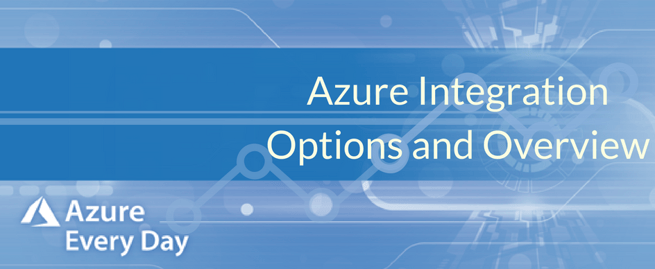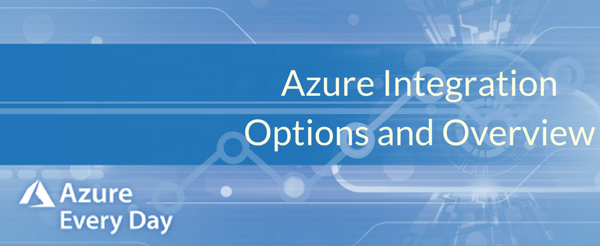Azure Integration Options and Overview


Today I’d like to talk about Azure Integration Services that you can leverage within the platform. Integration Services allow data to interact with other applications or businesses and to move data around within the platform. I’d like to discuss what is currently available, where it might fit, as well as give you an overview of the capabilities of Azure integration.
First, I’ll start with the more “business-friendly” options:
1. Flow – This workflow engine comes with Office 365. It’s a lightweight data integration engine that allows business users the ability to integrate between different types of applications. For example, you can use flow to integrate between SharePoint and drop data into email or use an email and drop data into Azure Storage. It’s set up to be simple to use and no custom coding is really allowed. Power users that are used to moving data around or have worked with SharePoint workflows will find this easy to transition to.
2. Logic Apps – Logic apps is available in Azure as opposed to Office 365. It does allow you to go after the code and create within the context of Visual Studio. Its graphical interface is almost identical to flow, with almost the same capabilities, but we can expand on those capabilities. It also gives you more around security and things that make it more IT friendly.
The other Integration Services get a bit more sophisticated and require development, but they give you better options around source control and other areas:
1. Service Bus – This is about moving messages around; it’s a message broker service. It handles data from all kinds of sources, on and off premises, cloud based, mobile, etc. It’s a highly scalable, high volume service and one of the most mature services in the Azure platform.
2. Azure Data Factory – This integration tool does a lot of the same types of workloads as SQL Server Integration Services or Informatica. With Azure Data Factory V2 coming out, you’ll have the ability to take SSIS and put it in as an integration runtime and run SSIS packages in the context of Azure Data Factory, thus making its capability even greater.
This awesome V2 version has a lot of capabilities that are not available in V1 and it has much more control around it. It enhances our ability to integrate data and ETL type of functionality and workflow.
3. Event Grid – This tool manages events coming off different devices and applications and simplifies the whole process of anything event driven. So, if you’re tracking events off an app or an IoT and trying to figure out what you’re going to do with that data or how you’re going to manage it, the event grid simplifies that infrastructure for you.
4. Web Job and Functions – Web jobs are part of the app service, functions are not, they are serverless. The idea behind these is they allow you to basically distribute code and have the ability to do other interactions.
So, you have all these options available for integration. The key is to understand what makes the most sense for you and your business. Each gives the opportunity to leverage it in a certain space, some have more expandability than others and some require more coding.
What you need to do is find the right tool for the job. In some cases, you may need more of a toolbox scenario, where you put pieces together, so you can get the best of all of them. You need to determine the best way to integrate the apps you have, from everywhere your apps and users exist, across your enterprise.
If you have questions about enterprise integration within Azure or to learn more about the tools that are available, you’re in the right place. Click the link below or contact us about this topic or anything Azure related—we’d love to help.
Sign-up now and get instant access
ABOUT THE AUTHOR
Free Community Plan
On-demand learning
Most Recent
private training




.jpg?width=406&name=Eans%20YouTube%20Thumbnails%20(2).jpg)


-1.png)
Leave a comment